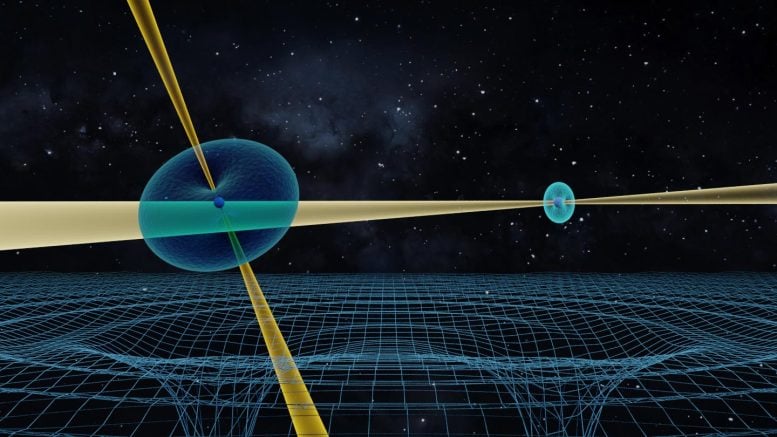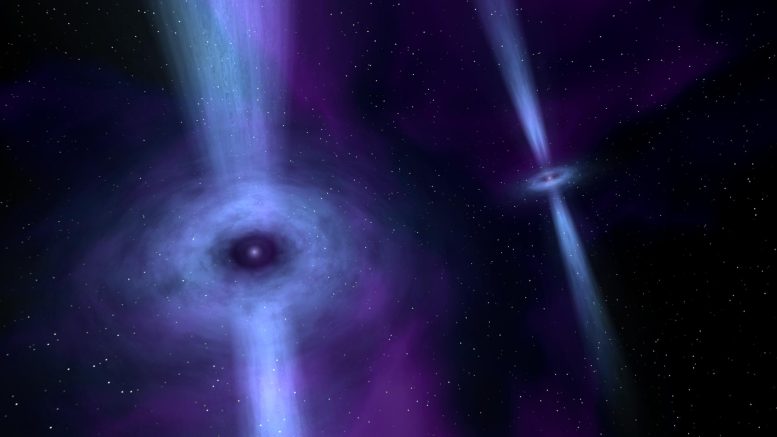
Researchers have conducted a 16-year long experiment to challenge Einstein’s theory of general relativity. The international team looked to the stars — a pair of extreme stars called pulsars to be precise – through seven radio telescopes across the globe. Credit: Max Planck Institute for Radio Astronomy
Researchers at the University of East Anglia and the University of Manchester have helped conduct a 16-year long experiment to challenge Einstein’s theory of general relativity.
The international team looked to the stars — a pair of extreme stars called pulsars to be precise – through seven radio telescopes across the globe.
And they used them to challenge Einstein’s most famous theory with some of the most rigorous tests yet.
The study, published today (December 13, 2021) in the journal Physical Review X, reveals new relativistic effects that, although expected, have now been observed for the first time.
Dr. Robert Ferdman, from UEA’s School of Physics, said: “As spectacularly successful as Einstein’s theory of general relativity has proven to be, we know that is not the final word in gravitational theory.

Researchers have conducted a 16-year long experiment to challenge Einstein’s theory of general relativity. The international team looked to the stars – a pair of extreme stars called pulsars to be precise – through seven radio telescopes across the globe. Credit: Max Planck Institute for Radio Astronomy
“More than 100 years later, scientists around the world continue their efforts to find flaws in his theory.
“General relativity is not compatible with the other fundamental forces, described by quantum mechanics. It is therefore important to continue to place the most stringent tests upon general relativity as possible, to discover how and when the theory breaks down.
“Finding any deviation from general relativity would constitute a major discovery that would open a window on new physics beyond our current theoretical understanding of the Universe.
“And it may help us toward eventually discovering a unified theory of the fundamental forces of nature.”
Led by Michael Kramer from the Max Planck Institute for Radio Astronomy in Bonn, Germany, the international team of researchers from ten countries, put Einstein’s theory to the most rigorous tests yet.
Dr. Ferdman said: “A pulsar is a highly magnetized rotating compact star that emits beams of electromagnetic radiation out of its magnetic poles.
“They weigh more than our sun but they are only about 15 miles across — so they are incredibly dense objects that produce radio beams that sweep the sky like a lighthouse.
“We studied a double pulsar, which was discovered by members of the team in 2003 and presents the most precise laboratory we currently have to test Einstein’s theory. Of course, his theory was conceived when neither these types of extreme stars, nor the techniques used to study them, could be imagined.”
The double pulsar consists of two pulsars which orbit each other in just 147 minutes with velocities of about 1 million km/h. One pulsar is spinning very fast, about 44 times a second. The companion is young and has a rotation period of 2.8 seconds. It is their motion around each other which can be used as a near perfect gravity laboratory.
Seven sensitive radio telescopes were used to observe this double pulsar – in Australia, the US, France, Germany, the Netherlands and in the UK (the Lovell Radio Telescope).
Prof Kramer said: “We studied a system of compact stars that is an unrivaled laboratory to test gravity theories in the presence of very strong gravitational fields.
“To our delight we were able to test a cornerstone of Einstein’s theory, the energy carried by gravitational waves, with a precision that is 25 times better than with the Nobel-Prize winning Hulse-Taylor pulsar, and 1000 times better than currently possible with gravitational wave detectors.”
He explained that the observations are not only in agreement with the theory, “but we were also able to see effects that could not be studied before”.
Prof Benjamin Stappers, from the University of Manchester, said: “The discovery of the double pulsar system was made as part of a survey co-led from the University of Manchester and presented us with the only known instance of two cosmic clocks which allow precise measurement of the structure and evolution of an intense gravitational field.
“The Lovell Telescope at the Jodrell Bank Observatory has been monitoring it every couple of weeks since then. This long baseline of high quality and frequent observations provided an excellent data set to be combined with those from observatories around the world.”
Prof Ingrid Stairs from the University of British Columbia at Vancouver, said: “We follow the propagation of radio photons emitted from a cosmic lighthouse, a pulsar, and track their motion in the strong gravitational field of a companion pulsar.
“We see for the first time how the light is not only delayed due to a strong curvature of spacetime around the companion, but also that the light is deflected by a small angle of 0.04 degrees that we can detect. Never before has such an experiment been conducted at such a high spacetime curvature.”
Prof Dick Manchester from Australia’s national science agency, CSIRO, said: “Such fast orbital motion of compact objects like these — they are about 30 percent more massive than the Sun but only about 24 km across — allows us to test many different predictions of general relativity — seven in total!
“Apart from gravitational waves and light propagation, our precision allows us also to measure the effect of “time dilation” that makes clocks run slower in gravitational fields.
“We even need to take Einstein’s famous equation E = mc2 into account when considering the effect of the electromagnetic radiation emitted by the fast-spinning pulsar on the orbital motion.
“This radiation corresponds to a mass loss of 8 million tonnes per second! While this seems a lot, it is only a tiny fraction — 3 parts in a thousand billion billion(!) — of the mass of the pulsar per second.”
The researchers also measured — with a precision of 1 part in a million(!) — that the orbit changes its orientation, a relativistic effect also well known from the orbit of Mercury, but here 140,000 times stronger.
They realized that at this level of precision they also need to consider the impact of the pulsar’s rotation on the surrounding spacetime, which is “dragged along” with the spinning pulsar.
Dr. Norbert Wex from the MPIfR, another main author of the study, said: “Physicists call this the Lense-Thirring effect or frame-dragging. In our experiment it means that we need to consider the internal structure of a pulsar as a neutron star.
“Hence, our measurements allow us for the first time to use the precision tracking of the rotations of the neutron star, a technique that we call pulsar timing to provide constraints on the extension of a neutron star.”
The technique of pulsar timing was combined with careful interferometric measurements of the system to determine its distance with high resolution imaging, resulting in a value of 2400 light-years with only an 8 percent error margin.
Team member Prof Adam Deller, from Swinburne University in Australia and responsible for this part of the experiment, said: “It is the combination of different complementary observing techniques that adds to the extreme value of the experiment. In the past similar studies were often hampered by the limited knowledge of the distance of such systems.”
This is not the case here, where in addition to pulsar timing and interferometry also the information gained from effects due to the interstellar medium were carefully taken into account.
Prof Bill Coles from the University of California San Diego agrees: “We gathered all possible information on the system and we derived a perfectly consistent picture, involving physics from many different areas, such as nuclear physics, gravity, interstellar medium, plasma physics and more. This is quite extraordinary.”
Paulo Freire, also from MPIfR, said: “Our results are nicely complementary to other experimental studies which test gravity in other conditions or see different effects, like gravitational wave detectors or the Event Horizon Telescope.
“They also complement other pulsar experiments, like our timing experiment with the pulsar in a stellar triple system, which has provided an independent and superb test of the universality of free fall.”
Prof Kramer added: “We have reached a level of precision that is unprecedented. Future experiments with even bigger telescopes can and will go still further.
“Our work has shown the way such experiments need to be conducted and which subtle effects now need to be taken into account. And, maybe, we will find a deviation from general relativity one day.”
Reference: “Strong-field Gravity Tests with the Double Pulsar” by M. Kramer et al., 13 December 2021, Physical Review X.
DOI: 10.1103/PhysRevX.11.041050
Post a Comment